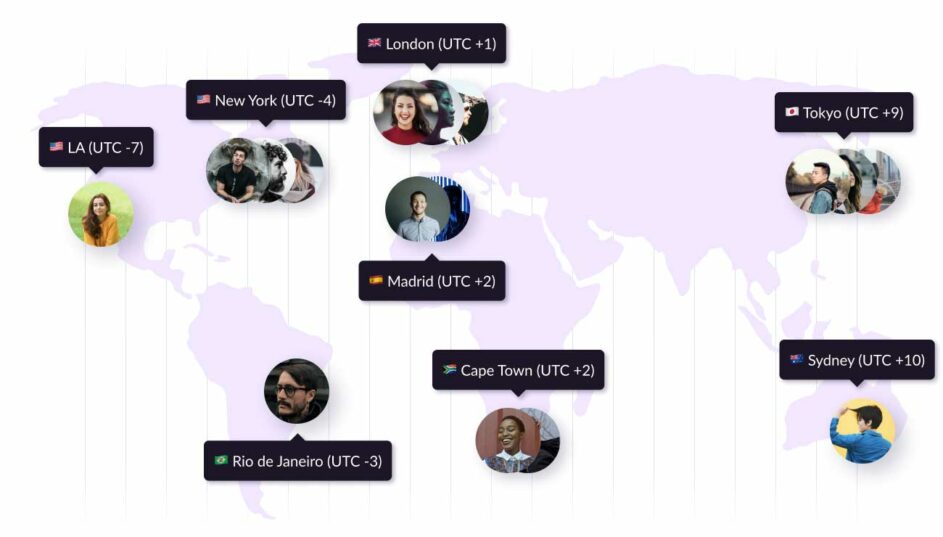If the thought of diving back into work after a relaxing holiday makes you want to immediately book another trip, we feel you. 87% of employees in a study from Zapier and Harris Poll admitted they “dread” aspects of returning to work after taking time off. For project managers, that dread usually stems from getting back up to speed on a ton of projects—which can feel like you’re walking right into a dumpster fire.
To lessen your sense of impending doom and hold onto those good vacation vibes, we’ve created a post-holiday game plan to help you seamlessly navigate projects your first week back. You can strategically break down what can seem like an overwhelming, scary amount of work into manageable pieces, making for a less stressful return to reality.
In this article 📖
Review projects with a methodical approach
Trying to address all your projects and any related roadblocks all at once makes for complete mental chaos. While you can’t control how your projects progressed (or didn’t) while you were OOO, you can control how you handle them now—and the best way to do that is with a clear system.
1. Deal with one project at a time
You might be tempted to pivot between projects to try to get up to speed, but a frantic back-and-forth makes it easier for things to fall through the cracks. Slow down and focus on one project at a time. Identify the most pressing projects by referring back to any out-out-of-office instructions or assignments you left for your team. If you didn’t create any sort of handover doc, start by reviewing the projects with the nearest deadlines.
2. Create a to-do-list with tasks sorted by priority levels
You might feel pressure to immediately dive into the most recent crisis du jour, but that’s not necessarily the most effective use of your time and energy. By reviewing all your projects first and creating a checklist of related action items and lingering questions, you’re forced to see the big picture instead of just one piece. In doing so, you can take more strategic, effective action that supports your projects and team across the board.
For each project, create a forecasting and resource report to get the gist of how it’s faring, get ahead of upcoming roadblocks, and answer these key questions to keep your iron triangle balanced:
- Cost: Are we still within our agreed-upon budget?
- Scope: Are there any new project tasks or issues with the quality of our deliverables?
- Time: Are we still on track to meet the agreed-upon deadline?
As you thoughtfully assess your project reports and related project messages in your inbox and tools like Slack, flag issues and document the steps you need to take to resolve those problems, like an unexpected sick day from your lead engineer or negative stakeholder feedback. If you don’t have access to software that gives you comprehensive visibility into project updates, ask your team members to message you if there were any budget, scope, or deadline changes that happened while you were away.
When writing your task list, we recommend sorting them into different priority “buckets” to organize your workload and help you focus on what matters most, first. These labels will help calm your brain down and keep things in perspective—not every project roadblock is a Category 5 catastrophe. The Eisenhower Matrix is a great framework, breaking things down into four clear and simple categories:
- Important and urgent
- Important and not urgent
- Not important and delegate
- Not important and delete
You can create your to-do list any way you’d like, but we personally like using platforms like Trello or Todoist. This way, you’ll have clear visibility into which tasks still need to be addressed, and you can easily remove items as you move along—there’s something seriously satisfying about watching a task vanish into the digital ether that you just don’t get from a pen and paper.
3. Set up project check-in calls
Now that you’ve established what you need to do to keep projects moving and grooving, it’s time to sync with your project teams. Clear communication is a cornerstone of successful projects and team morale—and it’s especially important post-holiday to make sure everyone is on the same page. Promptly scheduling catch-up calls with your internal team members and relevant stakeholders means you can promptly work together to affirm project expectations and resolve any dilemmas.
Use your priority task list to guide the order in which you set up your calls, and be sure to double-check time zones if you’re managing remote teams. Refer back to your task list when creating your meeting agendas to ensure you cover the most urgent project points.

Where possible, try to schedule your calls in time blocks. It might feel like a total slog going into back-to-back meetings, but it’ll actually give you a greater capacity to concentrate during the rest of your workday. Knocking meetings out in chunks will help you relieve some mental clutter and strain, and it gives you uninterrupted hours for productive deep work.
Get caught up on team capacity
Even when you’re in your regular work routine, it’s unlikely you’ll be able to remember everyone’s availability and schedules from memory—and definitely not when you’re coming back from holiday. To keep your projects and capacity planning on track, you need to get up to speed on what everyone’s working on and remedy any instances of over- or under-allocation.
This process will look different for everyone based on the tool(s) you use to keep track of your resource allocation. For instance, if you use integrated resource management software, you can quickly see everyone’s schedules—including PTO—on one master calendar that automatically calculates individual utilization rates. Then, you can just drag and drop assignments as needed to create balanced workloads.

Resource Guru gives you clear, real-time insight into everyone’s capacity.
Alternatively, if you keep track of availability in a manual tool or have separate leave management tech, you’ll need to carve out some time to update all the details and calculate resource utilization rates before you adjust any wonky workloads or plan new projects.
Whatever your process looks like, an accurate understanding of capacity is critical to keeping your projects humming and your team members happy. You know that awesome holiday you just took? How would it feel if your boss overlooked your PTO until the day before you were OOO, bombarded you with questions and asked for last-minute support finding coverage? The last thing you want to do is add stress to people’s plates when they’re getting ready to de-stress.
Review and update your own schedule
With all that out of the way, it’s time to turn to your calendar to make your tasks are best aligned with the natural ebb and flow of your personal productivity.
You’re not magically exempt from burnout just because you’re a project manager who knows all about the importance of preventing it. Just like you strive to keep your team members between a 70 to 80% utilization rate, that’s the same sweet spot you need for maximum productivity and minimal headaches.
It’s also important to protect your time. For example, if you’re someone who knows you work best before lunch but you scheduled meetings all morning, you’re setting yourself up for a struggle. While not every meeting is flexible, keep your calendar items and available hours synced up across platforms and visible to the rest of your team so you can stay in the zone as much as possible.
Be kind to yourself as you ramp back up
Treat yourself the same way you’d treat any other employee who is re-adjusting to work after a nice holiday: with patience and compassion. Post-vacation depression is a real thing, and you’ll only hurt your own mental health more by putting pressure on yourself to immediately hit your usual productivity and focus.
If you feel the overwhelming instinct to work late on your first day back, we highly, highly recommend you hit the pause button on that plan. Research shows that humans only have about four, maybe five solid hours of daily focus, so overtime doesn’t automatically translate to productive time. In fact, booking OT on your first day back will probably make you feel like you were never on that vacation in the first place. Instead, give yourself time and grace to get back into the flow of your normal work hours and reevaluate how you feel at the end of the week. Be sure to take regular breaks to recharge, chat with coworkers, and just get the heck out of your chair.
A single source of project truth makes returning to work less daunting
Getting your projects on point post-holiday can feel like a nightmare when you’re toggling between calendars, spreadsheets, and task-based apps. Skip the stress with our integrated project scheduling software. You gain total visibility into real-time employee availability, project progress, and client information in just one location. Try our 30-day free trial of Resource Guru and see how quickly your iron triangle balancing act improves.
Related Resource Guru reads:




